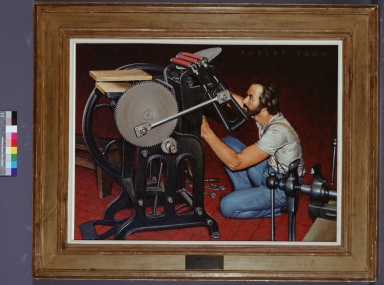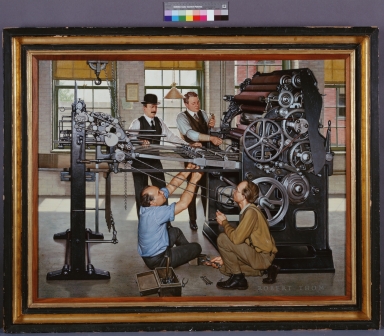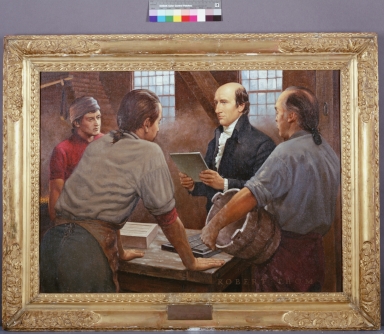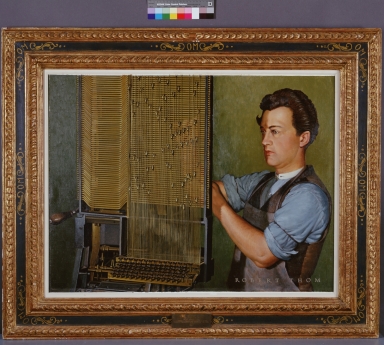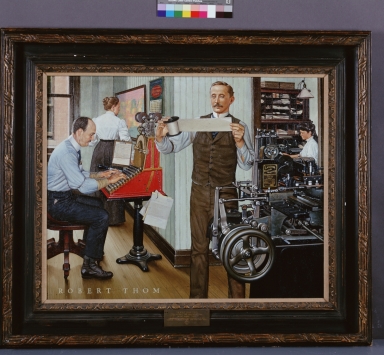|
REFINE
Browse All : Printing - Technological innovations and oil on canvas
1-9 of 9
Title
Frederic E. Ives and the Half-Tone Process
Creator
Thom, Robert A., 1915-1979
Summary
The method by which most pictures are processed for letterpress printing is called photoengraving. The procedure was developed in 1878 by Frederic E. Ives, an American technician and inventor from Philadelphia. Ives' method consists of breaking down photos or drawings into tiny dots of varying sizes. The image to be reproduced is photographed through a ruled glass screen which breaks up the different tones into dots, the number of which is determined by the fineness of the ruled lines on the screen. It is then etched into relief on a copper plate for letterpress printing.
Title
Friederich Koenig and the Cylindrical Press
Creator
Parrish, Douglas M., 1922-2001
Summary
After centuries of use, history's oldest printing machine, the hand press, was finally superseded when Frederich Koeing sold his first power-driven press to The London Times in 1814. Koeing's invention instantly lowered printing and composing costs by 25 per cent and made possible the production of cheaper and larger publications of every kind. His contributions to the graphic arts were presses with increased multiplying capacities which soon replaced manpower with machine power. From his inventions came today's entire line of modern, high speed printing machines.
Title
George P. Gordon and the Platen Press
Creator
Thom, Robert A., 1915-1979
Summary
The first of an illustrious line of Gordon job presses, standard equipment for commercial printing for years, was invented and put on the American market by George Phineas Gordon in 1851. The press was a small jobber operated by a treadle, and it had no throw-off. Gordon presses have appeared in various forms since the inventor's early model and are still operating and turning out job printing as efficiently as they did in the 19th century.
Title
Ira Rubel and the Offset Press
Creator
Thom, Robert A., 1915-1979
Summary
A milestone in graphic arts history occurred in the early 1900s when a New Jersey printer named Ira Rubel accidentally used a rubber cloth as a cylinder on a lithographic press. Due to Rubel’s negligence in feeding paper, an impression was made on the cloth. When the next sheet went through the press, an extremely vivid impression was obtained on its reverse side. On the basis of this principle, Rubel invented his offset press in 1905.
Title
Johann Gutenberg and Movable Type
Creator
Thom, Robert A., 1915-1979
Summary
Johann Gutenberg is popularly miscredited with inventing movable type in the 1450s. (This was invented in 1040 A.D. by Bi Sheng in Asia). His real contribution to the history of communications, however, was that he was the first man to successfully combine all the necessary printing components: type casting, ink manufacture, punch cutting, composing, a press and paper, into a single workable system and reach a point of technical efficiency which was not surpassed until the nineteenth century. Although another printer finished publishing his magnificent "42-Line Bible," poetic justice for his significant contributions led historians to attribute the entire accomplishment to Gutenberg.
Title
Lord Stanhope and Stereotyping
Creator
Thom, Robert A., 1915-1979
Summary
Shortly after the turn of the 19th century, Charles Mahon, Third Earl of Stanhope, became interested in reestablishing stereotype printing in England. Although stereotyping had twice been introduced in his country, it had fallen into disuse for many years. Stanhope, a political radical who ultimately seceded from the House of Lords, perfected stereotyping from plaster molds in 1804. His process offered many obvious advantages wherever books - such as bibles, prayer books and school books - were being constantly reprinted. It substantially reduced the wear of type and the expense of keeping it standing for future use.
Title
Lord Stanhope and Stereotyping
Creator
Thom, Robert A., 1915-1979
Summary
Shortly after the turn of the 19th century, Charles Mahon, Third Earl of Stanhope, became interested in reestablishing stereotype printing in England. Although stereotyping had twice been introduced in his country, it had fallen into disuse for many years. Stanhope, a political radical who ultimately seceded from the House of Lords, perfected stereotyping from plaster molds in 1804. His process offered many obvious advantages wherever books - such as bibles, prayer books and school books - were being constantly reprinted. It substantially reduced the wear of type and the expense of keeping it standing for future use.
Title
Ottmar Mergenthaler and the Linotype
Creator
Thom, Robert A., 1915-1979
Summary
On July 3, 1886 Ottmar Mergenthaler, an immigrant watchmaker from Wurttemberg, Germany demonstrated to the New York Tribune a machine which was regarded as one of the 10 greatest inventions of all time: the Linotype. Type for nearly every newspaper in the world and most books in the United States was composed by Mergenthaler's machine. His basic innovation was that of circulating matrices, pieces of brass punched with letters, figures and punctuation marks. When an operator tapped the Linotype's keys, the pieces were brought together into a line, automatically spaced, for faces which made a cast impression in type. The matrices were then automatically returned to the machine for future use.
Title
Tolbert Lanston and the Monotype
Creator
Thom, Robert A., 1915-1979
Summary
A year after Mergenthaler brought out his first Linotype in 1886, another inventor, Tolbert Lanston, received a patent on his composing machine, the Monotype. The principal advantage of the American's invention over the Linotype was that the Monotype could cast individual characters and assemble them in a justified line instead of setting an entire line of type, or slug. Lanston's machine, which was commercially established in 1894, has undergone many major improvements since its inception. But today Monotype setting is considered equal to or even superior to hand setting analog metal type.
1-9 of 9
|


